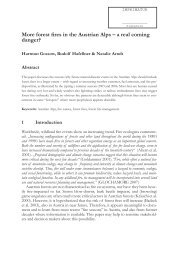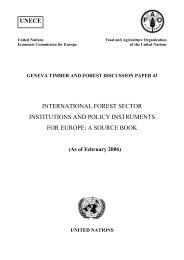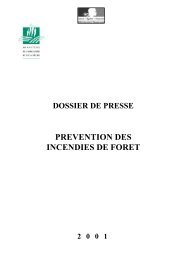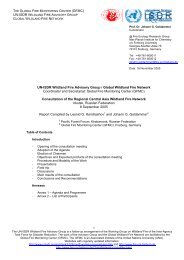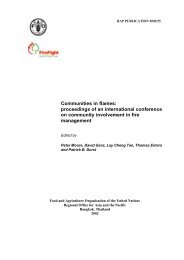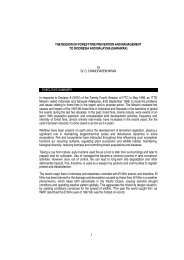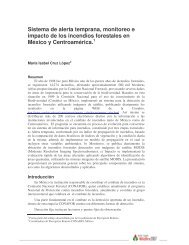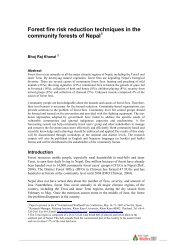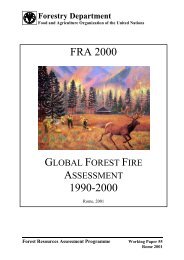the Churchill fires - 2009 Victorian Bushfires Royal Commission
the Churchill fires - 2009 Victorian Bushfires Royal Commission
the Churchill fires - 2009 Victorian Bushfires Royal Commission
You also want an ePaper? Increase the reach of your titles
YUMPU automatically turns print PDFs into web optimized ePapers that Google loves.
136<br />
Volume I: The Fires and <strong>the</strong> Fire-Related Deaths<br />
box 9.1 Forest industry brigades<br />
Under Victoria’s Country Fire Authority Act 1958 Hancock <strong>Victorian</strong> Plantations is required to maintain seven<br />
industry brigades to help protect its plantations. The company maintains crew and appliances well in excess<br />
of this statutory requirement. 49 Ms Linda Sewell, Chief Executive Officer of HVP, explained why HVP kept more<br />
crews: ‘Our application of resources is not about what our legal requirement is. It is what we believe is necessary<br />
in order to protect our people, our plantations and <strong>the</strong> communities in which our plantations are’. 50<br />
HVP firefighters are trained through <strong>the</strong> CFA and DSE. They carry pagers and are alerted about attendance at<br />
<strong>fires</strong> in <strong>the</strong> same way as CFA brigades. 51<br />
Although a forest industry brigade is responsible only for fire suppression on plantation holdings of <strong>the</strong> owner<br />
or group of owners who formed <strong>the</strong> brigade, <strong>the</strong> <strong>Commission</strong> was advised that HVP crews regularly attend <strong>fires</strong><br />
outside <strong>the</strong> company’s plantations, often some distance away. More than 50 per cent of <strong>the</strong> <strong>fires</strong> HVP’s forest<br />
industry brigades attend are not on HVP land. 52<br />
On 7 February HVP was in a high state of readiness. Personnel were located across HVP depots and in fire<br />
towers at Flynn, Longford and Stockdale, and heavy machinery—bulldozers, graders, and so on—was at various<br />
locations. Twelve HVP firefighters were patrolling for arson activity. 53<br />
HVP’s response to <strong>the</strong> firefighting effort was rapid and included subsequent despatch of resources to Yarram.<br />
The HVP <strong>Churchill</strong> office had staff ready for deployment to any fire that might break out on <strong>the</strong> day. In addition,<br />
an HVP fire coordinator was acting as a liaison officer at <strong>the</strong> ICC in Traralgon. 54<br />
At about 17:30 <strong>the</strong> incident management team received information about <strong>the</strong> impact of <strong>the</strong> wind change at Bunyip;<br />
this suggested <strong>the</strong> change would probably arrive earlier than 19:00. The Incident Controller directed that all aircraft<br />
be grounded and that red flag warnings be issued. 55<br />
Despite this, <strong>the</strong> air attack supervisor, Mr O’Toole, who had difficulty communicating with <strong>the</strong> incident management<br />
team throughout <strong>the</strong> day, received from <strong>the</strong> team no direct communication about <strong>the</strong> predicted change in <strong>the</strong><br />
wea<strong>the</strong>r. Ra<strong>the</strong>r, having noticed <strong>the</strong> wind becoming erratic at 17:27, he asked <strong>the</strong> air base for an update on <strong>the</strong><br />
forecast change. A few minutes later <strong>the</strong> base told him he should return immediately because a severe wind change<br />
was imminent. Mr O’Toole landed only minutes before <strong>the</strong> change arrived. He explained that if he and his pilot had<br />
still been airborne when <strong>the</strong> wind changed it would have posed ‘a significant threat to our safety’. 56<br />
At 17:47 <strong>the</strong> wind change passed through Boolarra, 5 kilometres south-west of where <strong>the</strong> fire had started and about<br />
26 kilometres west of <strong>the</strong> head of <strong>the</strong> fire. It was recorded at <strong>the</strong> Yarram automatic wea<strong>the</strong>r station at 18:03 and<br />
reached <strong>the</strong> fire’s area of origin by 18:05. 57<br />
The wind change turned <strong>the</strong> fire to <strong>the</strong> north-east, causing spotting towards Callignee, Traralgon South and Koornalla.<br />
A 13-kilometre-long uncontrolled flank of fire, running from <strong>the</strong> area of origin through to <strong>the</strong> east side of Mt Tassie,<br />
developed. Heavy fuel loads, steep terrain and <strong>the</strong> extreme wea<strong>the</strong>r caused <strong>the</strong> fire to produce huge pieces of airborne<br />
burning debris. Witnesses described <strong>the</strong> fire as ‘travelling as a mass of embers that ignited <strong>the</strong> surrounding vegetation<br />
almost instantly on <strong>the</strong>ir arrival, <strong>the</strong>n propagating more burning debris to become airborne again’. No warnings were<br />
issued for Koornalla, Callignee, Callignee South and Callignee North before <strong>the</strong> wind change. 58<br />
It was after <strong>the</strong> wind change that <strong>the</strong> fire was at its most dangerous; it progressively burned through Hazelwood<br />
North, Hazelwood South (where two people died), Koornalla (where four people died), Traralgon South, Callignee<br />
(where four people died), Callignee South, Callignee North, Jeeralang (where one person died), Jeeralang North,<br />
Devon, Yarram and Carrajung South and on to Won Wron State Forest. 59 Chapter 17 in this volume discusses <strong>the</strong><br />
circumstances surrounding <strong>the</strong> 11 deaths that occurred.<br />
Between 18:00 and 18:50 reports said that <strong>the</strong> fire was affecting properties in Koornalla, Callignee North,<br />
Hazelwood South, Hazelwood North and Traralgon South. 60





